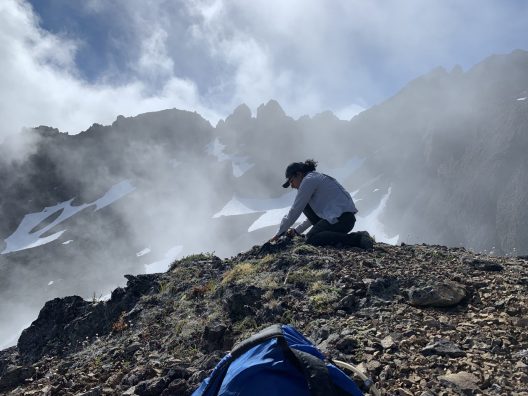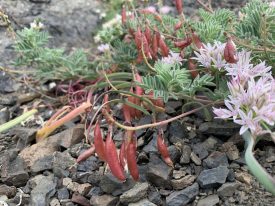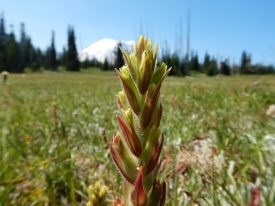Climate Change Vulnerability in the Alpine

This past September, Rare Care completed a three-year study to assess the vulnerability of rare alpine plants. Working with the National Park Service (NPS), Rare Care staff and seasonal interns mapped and monitored 159 populations found in National Parks in Washington to climate change, installed 26 long-term monitoring plots, collected seeds, assessed 26 focal species’ vulnerability to climate change, and developed adaptive management strategies that NPS could employ to mitigate the impacts of climate change.
The alpine zone is defined as the area above the tree line. Alpine habitats function like island chains in the sky, isolated from each other by unsuitable lowland habitats, which has promoted the proliferation of unique species found nowhere else. Living at the tops of mountains exposes alpine plants to ecological extremes and makes them uniquely vulnerable to climate change. Plants are adapted to survive under snow and ice for extended periods and are often reliant on snowbanks and snowmelt for moisture during their short growing season.
Climate change is predicted to cause warmer, drier summers and earlier snowmelt. Although species may migrate to follow their shifting ecological niches, for instance low-elevation species may move up the mountainsides, plants already at the top face the challenge of adapting to new neighbors and have nowhere to migrate themselves. Alpine areas are remote and difficult to access and traverse and data about these species to inform conservation efforts is often lacking.

cottonii)
For this project, Rare Care mapped 19 rare or understudied alpine plant species at 28 sites in Olympic, North Cascades, and Mt. Rainier National Parks from 2019 to 2022. We recorded each population’s extent, population size, flowering status, habitat details, associated species, and noted any potential threats. Most populations had never been mapped in detail, and Rare Care’s study provided NPS with baseline data to compare with future monitoring. However, population sizes we estimated for the Olympic endemic Astragalus australis var. cottonii at three of its seven populations revealed a 60% decrease since they were last monitored in 1985. Rare Care is working with Olympic National Park to investigate if these declines are occurring range wide.
We used the monitoring data and a review of existing literature to quantify species’ vulnerability and help NPS prioritize conservation efforts. These vulnerability assessments incorporated a species’ habitat preferences, interactions with other species, ability to adapt to changing conditions, and modeled exposure to climate change to rank the species’ relative risk. Most were at increased vulnerability due to their association with late season snowbanks, competition threats and inferred lack of genetic diversity.

For 16 of the species we mapped, we installed 26 long-term monitoring plots that can be resurveyed regularly to detect changes in the species’ abundance over time. We placed plots at the edge of the ecotone where we hypothesized the species may first retreat its habitat, for instance at the lowest elevation of the populations. We also collected seeds from eight of the focal species in Mt. Rainier and Olympic National Parks for ex situ conservation in the Miller Seed Vault.
Finally, Rare Care compiled a toolbox of conservation management techniques that NPS can use when population declines are observed. We recommended that regional and local endemics be prioritized and that the NPS work with other national parks and other land management agencies to expand seed collections to encompass a species’ full range. Although our effort produced the first mapping records available for many of the populations we visited, there were populations we did not have time to monitor. We are hopeful that the national parks will welcome volunteer involvement in the continued monitoring of these vulnerable and unique species.